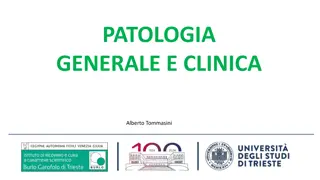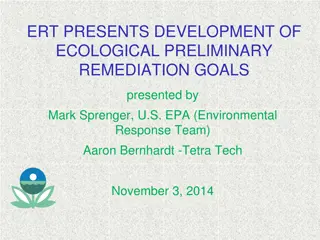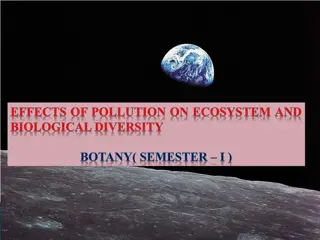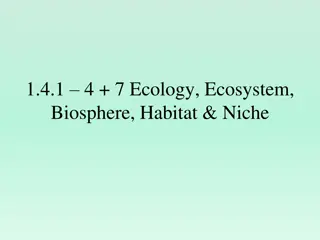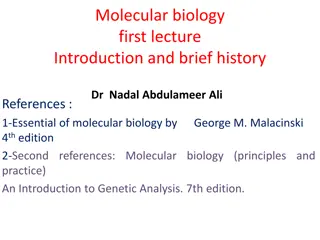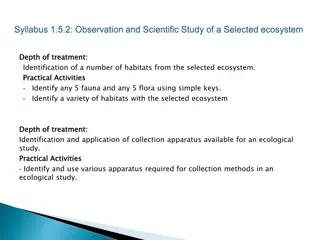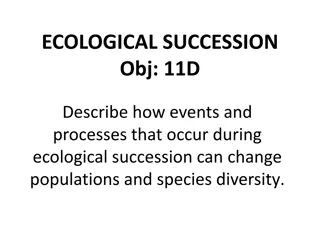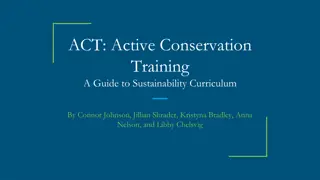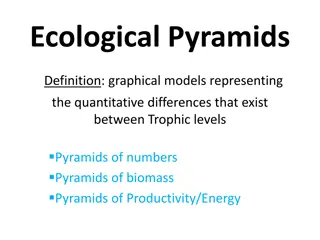Understanding Ecological Niches in Advanced Biology
In Advanced Higher Biology, the concept of ecological niches is explored in depth, considering both abiotic and biotic factors that impact an organism's role in its environment. The fundamental and realized niches are distinguished, along with the Competitive Exclusion Principle and examples like squirrel species competition. Resource partitioning is also discussed as a strategy for peaceful coexistence between species with similar requirements.
Download Presentation

Please find below an Image/Link to download the presentation.
The content on the website is provided AS IS for your information and personal use only. It may not be sold, licensed, or shared on other websites without obtaining consent from the author. Download presentation by click this link. If you encounter any issues during the download, it is possible that the publisher has removed the file from their server.
E N D
Presentation Transcript
The Parasite Niche Unit 2: Organisms and Evolution Advanced Higher Biology Miss Aitken
Ecological Niche In National 5, we learned that a niche is the role an organism plays in it s environment . However, at Advanced Higher, a more sophisticated definition is required. To work out the role an organism plays in it s environment, there are a number of factors that must be considered.
Ecological Niche The factors that must be considered: Abiotic factors non living temperature, moisture, pH, light intensity etc. Biotic factors living predators, disease, competition, parasitism etc. The ecological niche is best defined as the summary of tolerances and requirements of a species.
Fundamental Niche The fundamental niche of a species is the set of resources that the organism is capable of using, and living in, without competition from any other species. Realised Niche The realised niche of a species is the set of resources that the organism actually uses, and lives in, considering the competition from other species around it.
Competitive Exclusion Principle In some situations, two species with the same realised niche are in direct competition. During this competition, the weaker of the two species will eventually lose and may be lost from that area (local extinction). This is known as the competitive exclusion principle.
Competitive Exclusion Principle - Squirrels Red squirrels and grey squirrels have the same realised niche. Red squirrels are native to the UK, whereas grey squirrels were introduced from the US and Canada. Grey squirrels are larger than red squirrels and are able to eat seeds from some types of trees before they are ripe red squirrels cannot do this, and it has lead to local extinction in some areas.
Resource Partitioning When two species live in a habitat AND have similar requirements, it may be that their realised niches are different enough for them to co- exist peacefully. In this case, resource partitioning happens, where each species can exploit different components of the resource, reducing competition.
The Niche of Parasites Symbiosis association between organisms of different species Parasites are symbionts that gain nutrients at the expense of the host. Parasites use the host s resources to grow and to reproduce. The host is at a disadvantage as well as losing resources, it also must defend it s tissues from parasitic attack.
Parasite Groups Ectoparasites: Live and feed on the surface of hosts e.g. ticks, lice, fleas Endoparasites: Live and feed inside the host e.g. tapeworm and some types of bacteria and viruses.
Parasite Reproduction In a parasitic relationship, the parasite can produce many more offspring than the host. For example, a flea that lives on a cat can produce thousands of offspring in a year.
Co-Evolution as a Parasite A particular parasite has evolved in response to the evolution of it s host. This means that parasites have a very narrow niche and are very host-specific. They would find it very hard to live on a different host. Example: 3 different types of parasitic louse which live on different areas of the human body.
Parasites are Degenerate Because many of their needs are provided by the host, many parasites are degenerate. This means they lack the structures and organs that are found in other organisms. For example, tapeworms live in the human digestive system, surrounded by digested food. This means they no longer require a digestive system.
Parasite Lifecycles Parasite lifecycles can involve more than one host. Definitive host: Where the parasite reaches sexual maturity and so can carry out reproduction Intermediate host: Where the parasite develops Vector: A species which plays an active part in the transmission of a parasite. Sometimes vectors can also be hosts.



